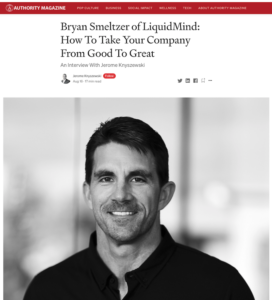By Bryan Smeltzer
AUTHORITY MAGAZINE INTERVIEW: How to Take Your Company from Good to Great
Had a recent interview with Authority Magazine #authoritymagazine on How to Take Your Company from Good to Great.
Let’s start with defining our terms. How would you define a “good” company, what does that look like? How would you define a “great” company, what does that look like?
In terms of point of difference, being Good vs being Great, a Good company is an average company, one that is “comfortable” doing the same thing day after day without much thought as to how to make their company different or how to pursue leadership within their product category or service.
In contrast, a Great company is never satisfied being comfortable; they are always looking for ways to extend their leadership position, provide value for their customer, drive a passionate culture, and execute relentlessly!
How this looks in real life is a Great brand or company is generational, they set the standard for their category, always blazing a path for others to follow. A Good company has an established base of commodity business where continuous innovation is not part of the plan, nor do they feel comfortable creating a vision around building something great.
For example, take Apple vs. Clorox; Apple is never satisfied, continually innovating, disrupting, and willing to take risks aggressively, while Clorox is comfortable with incremental updates and building a status quo culture.
Based on your experience and success, what are the five most important things one should know in order to lead a company from Good to Great? Please share a story or an example for each.
There are many Foundational Principles to building a Great company, but the five I find most critical to successfully taking a company from Good to Great are;
1. Vision; have a Visionary leader who can see the future and map out the path to achieving this goal. This trait is inherent in all Great companies, and without a Visionary, they will sail listlessly with no rudder or sail and no direction. This leader is the Passion behind the Vision. They will convey this visually and verbally, stay committed to its execution, and provide a clear definitive, execution plan for the team to follow. A true Visionary leader, one who shows the way (Vision) and shares (Humility) in all the credit!
A great example of Vision again is Apple, and I will go back to the Steve Jobs Gen. 2 era. When Steve had a Vision for what Apple could and should be, not what it was, it took a Vision and the ability to translate what they could not yet see to others. The famous line, “give them what they never knew they needed,” comes to mind. Unfortunately, this “future casting” is a scarce talent, and only a few Visionaries have ever possessed it. For those who have executed this “future casting”, it may take a generation before anyone truly understands the impact.
2. Risk Culture; fear of failure is a badge of honor for a Great brand or company. Failure can only happen if you are willing to take risks and embrace the learning process along the way. Inherently Risk is not reasonable if you are not learning, and providing a culture of accountability which limits your long-term exposure to Risk. No Great company has been built without embracing and championing failure, driven through Risk!
Having a Culture of Innovation is driven through a brand’s commitment to failure. But, unfortunately, failure is a byproduct of Risk and needed to create the impossible!
3. Disruptive by Design; Disruption is a term thrown around a lot these days, but true Disruption is Innovation on steroids. It is the next level of innovation and is a generational achievement once realized. Being Disruptive by Design means you are constantly trying to find a new process, a new service, a new method, a new product technology. I say new because Disruption is creating something completely new, from something that does not yet exist.
The iPod was innovative by design, but it was also Disruptive because it blew up the music industry and completely changed both the distribution and revenue models.
I was taught early on by the Visionary founder of Oakley, Mr. Jim Jannard, always looking for a breakaway design, one that puts you generations ahead of our competition. So do not worry about what our competition is doing because they will always be following our LEAD!
4. Positioning; all Great brands or companies are positioned as “best in class” by their customers and peers. To be the best, you must be perceived as the best. Perception is everything, and having a brand with a culture driven by its positioning will always have a loyal following. Take
Nike and Adidas; it is not that their products are significantly different from their Good counterparts; the perception and positioning have allowed them to stay Great! They have not violated this positioning nor moved away from their core foundational brand values.
5. Relentless execution; execution is the thread that pulls all Great brands together. Beyond the four mentioned, having a brand or a culture within your company that is seamless in accountability to each other and collaborative by nature is a beautiful thing to see in Great brands. Executing is built off a clearly defined Vision of what you would like your brand to achieve and be, while succeeding in building, both your product and culture.
Extensive research suggests that “purpose-driven businesses” are more successful in many areas. Can you help articulate for our readers a few reasons why a business should consider becoming a purpose-driven business or consider having a social impact angle?
Purpose Driven can have many different meanings, and I feel yes, a purpose-driven agenda can energize a brand. There are many causes or beliefs individuals may have, and they can embrace these purposefully for a brand.
To be perceived as Great, a company also needs to be perceived as caring, providing value beyond the product. Servant leadership is a principle embraced by many companies but committed to with Great companies, the ability to proactively serve each other for the betterment of someone personally or the brand itself professionally.
What would you advise to a business leader who initially went through years of successive growth but has now reached a standstill? From your experience, do you have any general advice about how to boost growth and “restart their engines”?
This is a widespread symptom of a company that may have lost its way and moved off what brought them down this path in the first place. In working with global iconic brands, truly generational ones, are they commit to “consistency”, they do not waver and twist in the wind when the going gets tough. They understand who their Brand is, what their Vision is, and how they will execute this in the marketplace.
Most brands or companies who “hit this wall” are ones who either were passive or not proactive in maintaining their lead. Fast-growing companies often do not take the time to check their pulse, understand what is going in the marketplace, address the warning signs, and adapt their company to future opportunities.
To “re-energize” a stale brand or company, there are several “core” leadership principles that need to be addressed;
1. Identify the issue; is it product or service-driven or leadership-driven?
2. Find the Opportunity; re-establish a leadership position, define the opportunity, and set the Vision going forward. This will energize the team.
3. Re-establish the Vision; re-set that which allowed you to be successful. The foundational principles on which you built your company. Be authentic, Be real with the team, and BE Committed to its success!
In your experience, which aspect of running a company tends to be most underestimated? Can you explain or give an example?
Culture, being able to continually drive the Passion and infuse the bloodlines of the company. Your team allows your company to be successful, and having a Culture envied by other brands is invaluable. By design, you want potential employees migrating to your company because of your Culture, the ability to succeed, the servant leadership principles provided, the camaraderie of the team, and the overriding Vision to be Great.
However, this is easier said than done; your Culture needs continual nurturing. This is not a tangible thing, and as a result, it can be damaged very quickly, and repairing this can take a long time.
While at Oakley, we had a great Culture built around crushing our competition and being relentless in all we do as a brand. This culture bled out to other brands and those who wanted to be a part of our Culture. Having an incredible Culture can not be bought, and it needs to be authentic and genuine.
As you know, “conversion” means to convert a visit into a sale. In your experience, what are the best strategies a business should use to increase conversion rates?
From the perspective of DTC branded conversion, several opportunities and investments can be made to enhance conversion rates.
With most consumer products brands we manage on a global scale with LiquidMind, the acquisition cost is a key metric and one we closely follow. You can deploy many different strategies, each relative to the brand positioning, product mix, channel, and seasonality.
One of the most effective conversion investments is through direct e-mail campaigns with a specific “add-on” value or discount applied. The “add-on” can be a gift, cross-promotion, or other CTA with an expiration attached. This is easily measured, produces the highest conversion rates and lowest acquisition cost. Of course, the best would be engagement opportunities/promotions through your social media, relative to your DEMO.
The third would be loyalty programs and true Value-driven benefits for your community beyond the product.
Each would be customized relative to the brand, but some of the most effective programs available would allow for extensive ROI campaign metrics.
Of course, the main way to increase conversion rates is to create a trusted and beloved brand. Can you share a few ways a business can earn a reputation as a trusted and beloved brand?
Stay authentic to your Foundation Principles and Positioning as a brand. Be authentic, and provide value beyond your product offerings. As Ralph Lauren once said, “We are selling a lifestyle, not a Product.” A company must understand that everyone has a product; what you do for your customer beyond the product will impact and build trust.
Also, trust is earned through doing what you say you will do, and it is incumbent on the entire brand to execute, from product to sales to customer service to fulfillment. So to fulfill the promise of a Great brand, stay true and stay authentic.
Great customer service and great customer experience are essential to build a beloved brand and essential to be successful in general. In your experience, what are a few of the most important things a business leader should know in order to create a Wow! Customer Experience?
A well-thought-out experience and understanding the “path to purchase” and what your customer encounters along with experience.
To create a great experience, you MUST create the unexpected. For example, it is expected to not talk with a Customer Service agent; it is not expected to have a clear status on shipment updates; it is not expected to have a seamless return and product credit process. Take a walk alongside your customer and your experiences in general and determine what a seamless experience is.
Once you have determined what is required to provide a unique purchase experience, the customer will take care of the rest. It is your choice as a brand, a good experience, or a GREAT experience delivered consistently on every transaction.
What are the most common mistakes you have seen CEOs & founders make when they start a business? What can be done to avoid those errors?
Interesting question, and one I recently answered in detail through my PODCAST, The Visionary Chronicles. The subject was a start-up, and the steps needed to avoid failure.
Most Start-ups fail; unfortunately, this is a fact of life. But why? Most fail ever to deliver a return for the investment, and a VC/PE firm will go in knowing the rate of success is 5%; their interest lies in the 5% left standing, not why the other 95% failed.
Too often, this equation and result seem to be driven by a simple cause and effect, a leadership team not prepared for success. By success I mean, defining a process typical to those who did succeed and missing from those who failed. Although this is often a cause for failure, it was not the money but rather a seamless, executable process to ensure your success.
Through years of being with iconic brands, working with generational brands through LiquidMind, and pier group studies, I have found that the following ten steps are where most companies fail while others succeed. Now, this is not the only reason, nor is it the definitive list, but it is a core compilation of some of the prevalent causes of failure;
1. Define the problem with a clear, well-defined Opportunity; Assure you understand all potential pitfalls to attaining your Vision, not just your tunnel Vision. Many Entrepreneurs see a great opportunity but fail to recognize all the detours they will need to realize their Vision.
2. Execute the Vision; Once you have clearly defined the Opportunity execute the plan to achieving this Opportunity. This is the time to simulate; test, fail, fail, fail option, refine the path and the solution.
3. Validate the Acceptance; get outside your four walls, and Validate your Assumptions. Right now, all you have is an IDEA, one that you have accepted; seek Acceptance from those who are targeting. Measure adoption, attrition, and value provided.
4. Balanced Decision Making; Risk is the path to success; however, balance decisions to limit Risk and move forward with caution.
5. Make IT Happen; have a clearly defined, executable plan w/ contingencies with alternate paths. Understand your Risk (pt. 4), learn to Adapt, and limit exposure.
6. Be Passionate; be a Visionary; carry the Torch both visually and verbally. Lead, and others will follow.
7. Bootstrap your way to Profitability; Profitability is the key to success; eventually, you will run out of money, and this will be your undoing. Ensure everyone understands their role and their piece of ensuring success.
8. Share the success; each is sacrificing, ensure they are rewarded through compensation, equity, and appreciation!
9. Expand and Thrive; stick to your Success Formula, adapt where needed, and grow your business.
10. SUCCEED; do not let up, keep your foot on the gas, exceed expectations of both your customer and team! Relentlessly INNOVATE and EXECUTE!
Being great starts at the top; it is the foundation for which all generational brands have thrived. The founding principles, the ability to adapt, the knowledge to know right and wrong, and culture are driven by a Passionate Vision to achieve Greatness.
Thank you for all of that. We are nearly done. You are a person of great influence. If you could start a movement that would bring the most amount of good to the most amount of people, what would that be? You never know what your idea can trigger. 🙂
There is not enough support for the Entrepreneurs community, true Founders, starting with nothing and building something of value to others.
I know the struggles they face and the trials or barriers they have to overcome daily. This stress sets in and eventually bleed itself into both their professional and personal life. They need support and may not always know where to turn or find a trustworthy resource with no ulterior motive.
This is why I started the Christian Entrepreneur Leadership Ministry at Saddleback Church in Lake Forest, CA. Yes, the same church was led by Pastor Rick Warren, author of the Purpose Driven Life.
I hope this Ministry provides a valued service to those in need of support and a trusting environment of other Entrepreneurs with no ulterior motive other than to serve others.
How can our readers further follow you online?
• LiquidMind Inc.; LiquidMindsite.com
• Personal; BryanSmeltzer.com
• PODCAST; The Visionary Chronicles PODCAST
• The Visionary Chronicles (APPLE)
© All Rights Reserved, Bryan Smeltzer, 2021https://www.linkedin.com/embeds/publishingEmbed.html?articleId=8928675450154778599https://www.linkedin.com/embeds/publishingEmbed.html?articleId=8416450692267949962
#thevisionarychronicles
#bryansmeltzerauthoritymagazine
#leadershipprinciples
Published by
Status is onlineBryan SmeltzerPresident | Business Strategy | Author | Speaker | Advisor | Board Member | Consumer Products at LiquidMindPublished • 4m191 articlesAUTHORITY MAGAZINE INTERVIEW: How to Take Your Company from Good to Great My recent interview with Authority Magazine hashtag#authoritymagazine on taking your brand from being just Good, to being Great! hashtag#brandingstrategyhashtag#greatnesshashtag#entrepreneuradvicehashtag#entrepreneurjourneyhashtag#leadershiphashtag#thriveglobalBryan SmeltzerLiquidMind Inc.





